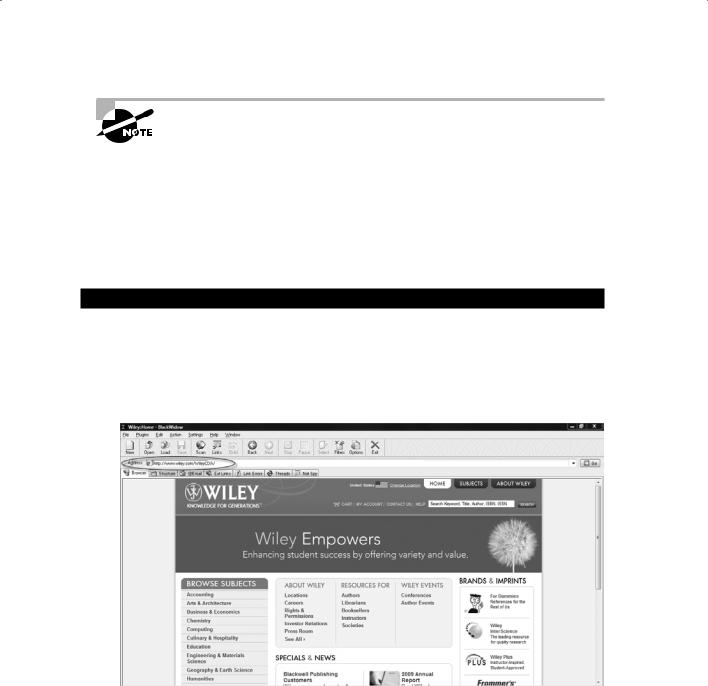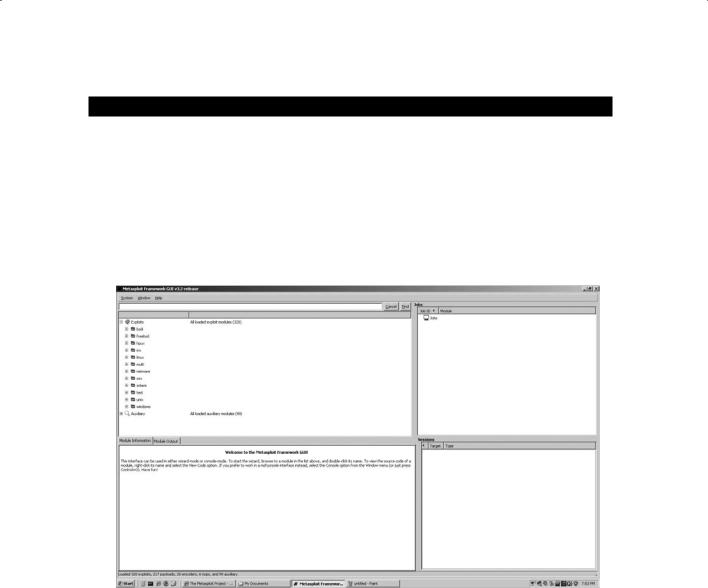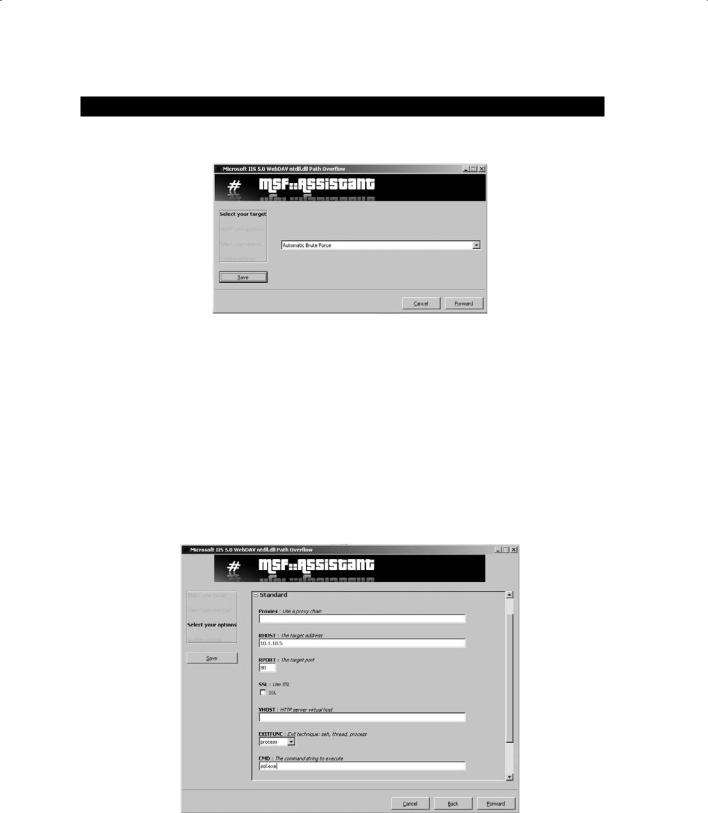
- •Acknowledgments
- •About the Author
- •Contents at a Glance
- •Contents
- •Table of Exercises
- •Introduction
- •Assessment Test
- •Answers to Assessment Test
- •Defining Ethical Hacking
- •How to Be Ethical
- •Keeping It Legal
- •Summary
- •Exam Essentials
- •Review Questions
- •Answers to Review Questions
- •Reconnaissance
- •Information-Gathering Methodology
- •Social Engineering
- •Summary
- •Exam Essentials
- •Review Questions
- •Answers to Review Questions
- •Scanning
- •Enumeration
- •Summary
- •Exam Essentials
- •Review Questions
- •Answers to Review Questions
- •The Simplest Way to Get a Password
- •Types of Passwords
- •Cracking a Password
- •Understanding Keyloggers and Other Spyware Technologies
- •Escalating Privileges
- •Understanding Rootkits
- •Hiding Files
- •Understanding Steganography Technologies
- •Summary
- •Exam Essentials
- •Review Questions
- •Answers to Review Questions
- •Trojans and Backdoors
- •Viruses and Worms
- •Summary
- •Exam Essentials
- •Review Questions
- •Answers to Review Questions
- •How a Sniffer Works
- •Sniffing Countermeasures
- •Bypassing the Limitations of Switches
- •Wireshark Filters
- •Summary
- •Exam Essentials
- •Review Questions
- •Answers to Review Questions
- •Denial of Service
- •Session Hijacking
- •Summary
- •Exam Essentials
- •Review Questions
- •Answers to Review Questions
- •How Web Servers Work
- •Types of Web Server Vulnerabilities
- •Web Application Vulnerabilities
- •Summary
- •Exam Essentials
- •Review Questions
- •Answers to Review Questions
- •SQL Injection
- •Buffer Overflows
- •Summary
- •Exam Essentials
- •Review Questions
- •Answers to Review Questions
- •Wi-Fi and Ethernet
- •Authentication and Cracking Techniques
- •Using Wireless Sniffers to Locate SSIDs
- •MAC Filters and MAC Spoofing
- •Rogue Access Points
- •Wireless Hacking Techniques
- •Securing Wireless Networks
- •Summary
- •Exam Essentials
- •Review Questions
- •Answers to Review Questions
- •Components of Physical Security
- •Understanding Physical Security
- •Physical Site Security Countermeasures
- •What to Do After a Security Breach Occurs
- •Summary
- •Exam Essentials
- •Review Questions
- •Answers to Review Questions
- •Linux Basics
- •Compiling a Linux Kernel
- •GCC Compilation Commands
- •Installing Linux Kernel Modules
- •Linux Hardening Methods
- •Summary
- •Exam Essentials
- •Review Questions
- •Answers to Review Questions
- •Types of IDSs and Evasion Techniques
- •Summary
- •Exam Essentials
- •Review Questions
- •Answers to Review Questions
- •Generating Public and Private Keys
- •Cryptography Algorithms
- •Summary
- •Exam Essentials
- •Review Questions
- •Answers to Review Questions
- •Defining Security Assessments
- •Penetration Testing
- •Pen Test Deliverables
- •Summary
- •Exam Essentials
- •Review Questions
- •Answers to Review Questions
- •Glossary
- •Index

This chapter introduces the essentials of hacking web servers and exploiting web server and web application vulnerabilities. Web-based password-cracking techniques are also covered.
Web servers and web applications have a very high potential to be compromised. The primary reason for this is that the systems that run web server software must be publicly available on the Internet. The web server cannot be completely isolated and to some degree must be available to legitimate users. Once a web server has been compromised, the system can provide hackers with another door into the network. Not only the web server software but also applications that run on the web server are open to attack and can be exploited. Due to their function, web servers are more accessible than other systems and less protected, so they’re easier to exploit.
The target information on a web server usually resides in a database on the web server; this database is accessed via a web application. For this reason, web servers and web applications go hand in hand. Compromising the web server is usually done to gain access to the underlying data in the web application.
How Web Servers Work
Web servers use Hypertext Transfer Protocol (HTTP) and Hypertext Transfer Protocol Secure (HTTPS) to allow web-based clients to connect to them and view and download files. HTTP is an Application-layer protocol in the TCP/IP stack. HTTP and HTTPS are the primary protocols used by web clients accessing web pages residing on web servers on the Internet. Hypertext Markup Language (HTML) is the language used to create web pages and allows those pages to be rendered in web browser software on web clients.
The HTTP protocol operates as shown in Figure 8.1.
F i g u r e 8 .1 HTTP protocol components
|
Internet |
|
Firewall |
Firewall |
Web |
|
|
|
Web |
Web |
Application |
Client |
Server |
and Database |

198 Chapter 8 n Web Hacking
1.The web client initially opens a connection to the web server IP address using TCP port 80.
2.The web server waits for a GET request from the client requesting the home page for the website.
3.The web server responds with the HTML code for the web server home page.
4.The client processes the HTML code and the web client’s browser software renders the page on the client device.
Understanding how web servers work—and consequently how they are hacked—is an important part of your job as a CEH. This includes knowing their vulnerabilities, as well as understanding the types of attacks a hacker may use. In addition, you should know when to use patch-management techniques and understand the methods used to harden web servers.
We’ll look at all these topics in the following sections.
Types of Web Server Vulnerabilities
Web servers, like other systems, can be compromised by a hacker. The following vulnerabilities are most commonly exploited in web servers:
Misconfiguration of the Web Server Software A common issue with using Microsoft’s Internet Information Server (IIS) as a web server is the use of the default website. The permissions on the default website are open, meaning the default settings leave the site open to attack. For example, all users in the everyone group have full control to all the files in the default website directory. It is critical to edit and restrict permissions once IIS is installed on the server as the default system user, IUSR_COMPUTERNAME, is a member of the everyone group. Consequently, anyone accessing the default website will be able to access all files in the default website folder and will have dangerous permissions such as Execute and Full Control to the files. See Exercise 8.1 to learn how to disable the default website in IIS.
Operating System or Application Bugs, or Flaws in Programming Code All programs, including the OS and web server applications, should be patched or updated on a regular basis. For Windows systems, this includes security patches, hotfixes, and Windows Updates. All of these patches can be automated or manually applied to the systems once they have been tested.
Vulnerable Default Installation Operating system and web server software settings should not be left at their defaults when installed, and should be updated on a continuous basis.
Hackers exploit these vulnerabilities to gain access to the web server. Because web servers are usually located in a demilitarized zone (DMZ)—which is a publicly accessible area between two packet filtering devices and can be easily accessed by the organization’s client systems—an exploit of a web server offers a hacker easier access to internal systems or databases.

Types of Web Server Vulnerabilities |
199 |
E x e r c i s e 8 .1
Disabling the Default Website in Internet Information Server
To disable the default website in IIS and add a new site, follow these steps:
1.Open IIS on your Windows Server or virtual machine (VM).
2.Select Web Sites in the left pane.
3.Right-click the default website in the right pane and select Stop from the context menu. The default website is now stopped.
4.To create a new site, right-click Web Sites in the left pane and select New Web Site.
5.The Web Site Creation Wizard launches. Within the wizard will be a screen to change permission on the website directory.

200 Chapter 8 n Web Hacking
Website cloaking is the ability of a web server to display different types of web pages based on the user’s IP address.
cases, it is useful to gather all or a portion of the files that make up a website. One option is to right-click any web page and select View Source from the context menu. This command will open up a new window with the source code for the page. You can then save the text file as a document on the local machine. This approach works, but it isn’t a practical way of copying all the files for a target website. An easy-to-use program called BlackWidow can make the process of copying website files much easier. Exercise 8.2 shows you how to use the BlackWidow program to copy an entire website or a portion of the site.
E x e r c i s e 8 . 2
Using BlackWidow to Copy a Website
1.Download and install the BlackWidow application from www.softbytelabs.com.
2.Open the BlackWidow program.
3.Enter a target website address in the BlackWidow address bar:
4.Click the Scan button on the BlackWidow toolbar.
5.Click the Structure tab.

Types of Web Server Vulnerabilities |
201 |
E x e r c i s e 8 . 2 ( c o n t i n u e d )
6.Browse the website folder structure. Right-click a file or folder and choose Copy Selected Files to copy the website files to your computer.
Attacking a Web Server
Web servers typically listen on TCP port 80 (HTTP) and TCP port 443 (HTTPS). Because those ports must be open and available to web clients, any firewalls or packet filtering devices between the web client and web server must pass traffic destined for those ports. Web application software sits on top of the web server software and allows access to additional ports. One of the initial information-gathering steps targeting web servers is banner grabbing. Banner grabbing is an attempt to gather information about a web server such as the OS and
web server software and version. Exercise 8.3 shows you how to use banner grabbing.
E x e r c i s e 8 . 3
Banner Grabbing
1.At the command prompt on your Windows PC, type
telnet <IPaddress> 80
The IP address is the address of the web server target. Also, the URL can be used instead of the IP address.
2.Next, in the telnet window type
HEAD/HTTP/1.0
Then press Enter.
The web server banner will then be returned. The banner will look something like the following:
Server: Microsoft-IIS/5.0
Date: Fri, 14 Aug 2009 1:14:42 GMT
Content-Length:340
Content-Type: text/html

202 Chapter 8 n Web Hacking
The banner grabbing result will usually identify the web server type and version. This information is important because exploits against this web server type and version can be identified. The next step after banner grabbing would be to attack the web server or attack a web application and gain access to data on the server.
A benign but visible type of attack against web servers is defacement. Hackers deface websites for sheer joy and an opportunity to enhance their reputations rather than gathering any useful data. Defacing a website means the hacker exploits a vulnerability in the OS or web server software and then alters the website files to show that the site has been hacked. Often the hacker displays their hacker name on the website’s home page.
Common website attacks that enable a hacker to deface a website include the following:
NN |
Capturing administrator credentials through man-in-the-middle attacks |
|
|
NN |
Revealing an administrator password through a brute-force attack |
NN |
Using a DNS attack to redirect users to a different web server |
NN |
Compromising an FTP or email server |
|
|
NN |
Exploiting web application bugs that result in a vulnerability |
NN |
Misconfiguring web shares |
NN |
Taking advantage of weak permissions |
|
|
NN |
Rerouting a client after a firewall or router attack |
NN |
Using SQL injection attacks (if the SQL server and web server are the same system) |
NN |
Using telnet or Secure Shell (SSH) intrusion |
|
|
NN |
Carrying out URL poisoning, which redirects the user to a different URL |
NN |
Using web server extension or remote service intrusion |
NNIntercepting the communication between the client and the server and changing the cookie to make the server believe that there is a user with higher privileges (applies to cookieenabled security)
Exercise 8.4 walks you through using the Metasploit Framework to exploit a web server vulnerability.
It is important that the machine or VM have all antivirus and firewall programs completely shut down prior to installing Metasploit. Otherwise, the antivirus or firewall can block some components of Metasploit, causing it not to function or open properly. As we mentioned in the lab setup guide in the Introduction to this book, you should never install Metasploit on a production machine. Use either a VM or lab test machine to run this software.

Types of Web Server Vulnerabilities |
203 |
E x e r c i s e 8 . 4
Using Metasploit to Exploit a Web Server Vulnerability
1.Download and install Metasploit 3.2 on your Windows XP or Vista computer or VM (www.metasploit.com).
2.Choose all the default options when installing Metasploit.
3.Select the Online Update option in the Metasploit 3 folder under Programs.
4.After the online update has completed, open the Metasploit GUI file in the Metasploit 3 folder.
5.Expand the Windows folder under Exploits and then expand the IIS folder.

204 Chapter 8 n Web Hacking
E x e r c i s e 8 . 4 ( c o n t i n u e d )
6.Double-click the ms03_007_ntdll_webdav exploit. The MSF Assistant Wizard launches.
7.Click the Forward button to move to the next screen of the wizard.
8.Select Windows/Exec from the Payload drop-down list, and then click Forward.
9.Type the IP address of the target IIS web server in the RHOST field. This server should be an unpatched version of Windows 2000 for this particular payload to work. If that is not the case, choose a different payload to which the server is vulnerable.
10.Type sol.exe in the CMD field. This is the executable that will be run on the remote target host. sol.exe is the solitaire game, which should be on all Windows operating systems. The payload is what will be delivered to the target system. In this case, it
is similar to typing sol.exe at the command prompt of the IIS server. Obviously this executable is benign, but this exercise illustrates how a more dangerous executable, such as a virus or Trojan, could be run on a target system.

Types of Web Server Vulnerabilities |
205 |
E x e r c i s e 8 . 4 ( c o n t i n u e d )
11.Click the Forward button to move to the next screen of the wizard.
12.Click the Apply button. The exploit will appear under Jobs until it is delivered to the target system.
13.Confirm in the Windows IIS Server VM or on the IIS PC that the Solitaire program is running. If the program is not running, confirm that Solitaire is installed on the IIS server and try the Metasploit exploit again.
Hacking Internet Information Server
Windows IIS is one of the most popular web server software products. Because of the popularity and number of web servers running IIS, many attacks can be launched against IIS servers. The three most common attacks against IIS are as follows:
NN |
Directory traversal |
NN |
Source disclosure |
NN |
Buffer overflow |
A directory-traversal attack is based on the premise that web clients are limited to specific directories within the Windows files system. The initial directory access by web clients is known as the root directory on a web server. This root directory typically stores the home page usually known as Default or Index, as well as other HTML documents for the web server. Subdirectories of the root directory contain other types of files; for example, scripts may contain dynamic scripting files for the web server. The web server should allow users to access only these specific directories and subdirectories of root. However, a directorytraversal attack permits access to other directories within the file system.
Windows 2000 systems running IIS are susceptible to a directory-traversal attack, also known as the Unicode exploit. The vulnerability in IIS that allows for the directory traversal/Unicode exploit occurs only in unpatched Windows 2000 systems and affects CGI scripts and Internet Server Application Programming Interface (ISAPI) extensions such as
.asp. The vulnerability exists because the IIS parser was not properly interpreting Unicode, thus giving hackers system-level access.
Essentially, Unicode converts characters of any language to a universal hex code specification. However, the Unicode is interpreted twice, and the parser only scans the resulting request once (following the first interpretation). Hackers could therefore sneak file requests through IIS. For example, utilizing %c0% af instead of a slash in a relative pathname exploits the IIS vulnerability. In some cases, the request lets the hacker gain access to files that they otherwise shouldn’t be able to see. The Unicode directory traversal vulnerability allows a hacker to add, change, or delete files, or upload and run code on the server. The ability to add or run files on the system enables a hacker to install a Trojan or backdoor on the system.

206 Chapter 8 n Web Hacking
IIS Unicode exploit is an outdated vulnerability and is presented in this text as a proof of concept—that is, proof that the vulnerability exists and can be exploited.
Buffer overflow attacks are not unique to web servers and can also be launched against other types of systems. A buffer overflow involves sending more data, usually in the form of a text string, than the web server is capable of handling. The primary entry point for buffer overflows is a web form on the web server. Buffer overflows and countermeasures will be covered in detail in the next chapter.
Source disclosure attacks occur when the source code of a server application can be gathered. Source disclosure attacks can lead to a hacker identifying the application type, programming language, and other application-specific information. All this information can allow a potential hacker to identify security holes and potential exploits that can be delivered to the web server. Again, most of a hacker’s time is spent gathering information about a target in order to identify the best point of entry for an exploit.
Putting It All Together Using Source Disclosure Attacks
An example of performing a source disclosure attack would be to run BlackWidow against a web server and copy all the files to a local directory. In reviewing the source files from BlackWidow, you can obtain the name of the server, the IP address, and the version. Additional information-gathering tools such as Netcraft can aid in the discovery of the OS, web server software type, and version. Additional information may be gathered regarding the JavaScript (.js files) or Active Server Pages (.asp files) that reside on the server. Based on the web server applications and vulnerabilities, Metasploit can be used to deliver a payload to the server. Depending on the patch level and vulnerability, the payload can be fairly benign or serious enough to cause the hacker to gain access to valuable data. The best countermeasure to the source disclosure attack and other types of attacks is to patch the OS, web server, and all server applications to the most current level and maintain an active patch-management program.
A CEH must be aware of all the information-gathering techniques to identify potential vulnerabilities in web servers and web applications. The reason this knowledge is so important for the CEH is so that they can defend against the same attacks and implement countermeasures to prevent attacks.

Types of Web Server Vulnerabilities |
207 |
Patch-Management Techniques
Patch management plays a critical role in preventing and mitigating the risk of attack against web servers and web applications. Patch management is the process of updating appropriate patches and hotfixes required by a system vendor. Proper patch management involves choosing how patches are to be installed and verified, and testing those patches on a nonproduction network prior to installation.
You should maintain a log of all patches applied to each system. To make patch installation easier, you can use automated patch-management systems provided by PatchLink, St. Bernard Software, Microsoft, and other software vendors to assess your systems and decide which patches to deploy.
First Week on the Job as a Web Administrator
As a newly hired network administrator for a small company of 40 employees, it was my responsibility to review the configuration and patches for a small network with two servers. The company used IIS 5.0 on a Windows 2000 server that had been serving the corporate website to clients for three years. The servers had been installed and configured by a consulting company three years prior to my joining the staff. The website content was updated regularly by the marketing assistant, but no other update had been made to the server.
So, I embarked upon updating and performing patch management on the web server. The company had no firewall protecting the Internet connection, and the Windows Server OS had not had any patches or hotfixes applied to it since installation. The IIS web server software was also out of date. All of this presented a huge security risk to the organization, and patch management was the highest priority to protect the web server and applications running on it.
As I applied security patches and hotfixes, to first the OS and then IIS, I found that malware, such as the Code Red worm and numerous viruses, had already attacked the system. It took several days of applying patches and hotfixes and updating virus definitions before the web server was brought up-to-date. Luckily for the small company, I was able to bring the OS and web server software up-to-date and implement a system for patch management before the network was damaged or a serious security breach occurred.

208 Chapter 8 n Web Hacking
Hacking Tools
N-Stalker Web Application Security Scanner allows you to assess a web application for a large number of vulnerabilities, including cross-site scripting, SQL injection, buffer overflow, and parameter-tampering attacks.
The Metasploit Framework is a freeware tool used to test or hack operating systems or web server software. Exploits can be used as plug-ins, and testing can be performed from a Windows or Unix platform. Metasploit was originally a command-line utility, but it now has a web browser interface. Using Metasploit, hackers can write their own exploits as well as utilize standard exploits.
CORE IMPACT and SAINT Vulnerability Scanner are commercial exploit tools used to test and compromise operating systems and web server software.
Web Server Hardening Methods
A web server administrator can do many things to harden a server (increase its security). The following are ways to increase the security of the web server:
NNRename the administrator account, and use a strong password. To rename the administrator account in Windows, open the User Manager, right-click the Administrator account, and select Rename.
NNDisable default websites and FTP sites. The process to disable default websites was described earlier in this chapter: right-click the default website in IIS Manager and choose Stop. The same process works for the default FTP site.
NNRemove unused applications from the server, such as WebDAV. Unnecessary applications can be removed on a server by using Add/Remove Programs in the Windows Control Panel.
NN |
Disable directory browsing in the web server’s configuration settings. |
NNAdd a legal notice to the site to make potential attackers aware of the implications of hacking the site.
NNApply the most current patches, hotfixes, and service packs to the operating system and web server software.
NNPerform bounds checking on input for web forms and query strings to prevent buffer overflow or malicious input attacks.
NN |
Disable remote administration. |
NN |
Use a script to map unused file extensions to a 404 (“File not found”) error message. |
NN |
Enable auditing and logging. |
